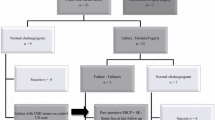Abstract
Background
Symptoms of choledochal cysts sometimes persist or become exacerbated. As preoperative management for patients with these cysts, we prospectively employed endoscopic drainage, based on the theory that protein plugs cause symptoms by obstructing the pancreatobiliary ducts.
Methods
Children with choledochal cysts underwent endoscopic retrograde cholangiopancreatography (ERCP). When ERCP showed compaction with filling defects in patients with persistent or worsening symptoms (study patients), the placement of a short biliary stent tube was attempted for drainage. The clinical and ERCP findings of the study patients were compared with those of patients who were asymptomatic at ERCP (asymptomatic patients).
Results
There were 13 study patients (median age 2.9 years) and 41 asymptomatic patients (4.7 years) enrolled in the study between August 2005 and February 2011. Study patients more frequently had jaundice and elevated transaminase levels. ERCP showed that all study patients had obstruction or compacted filling defects in the common channel or the narrow segment distal to the cyst. Insertion of a stent tube was successful in 11 patients. Symptoms were relieved soon after biliary drainage. Surgery revealed that the obstructing materials were protein plugs, except in one case, which involved fatty acid calcium stones.
Conclusions
These results support the protein plug theory. Endoscopic short-tube stenting is adequate and effective as preoperative management.

Similar content being viewed by others
References
Kaneko K, Ando H, Ito T, Watanabe Y, Seo T, Harada T, et al. Protein plugs cause symptoms in patients with choledochal cysts. Am J Gastroenterol. 1997;92:1018–21.
Ando H, Ito T, Watanabe Y, Seo T, Kaneko K, Nagaya M. Spontaneous perforation of choledochal cyst. J Am Coll Surg. 1995;181:125–8.
Fumino S, Iwai N, Deguchi E, Ono S, Shimadera S, Iwabuchi T, et al. Spontaneous rupture of choledochal cyst with pseudocyst formation—report on 2 cases and literature review. J Pediatr Surg. 2006;41(6):e19–21.
Tagge EP, Tarnasky PR, Chandler J, Tagge DU, Smith C, Hebra A, et al. Multidisciplinary approach to the treatment of pediatric pancreaticobiliary disorders. J Pediatr Surg. 1997;32:158–64.
Lal R, Agarwal S, Shivhare R, Kumar A, Sikora SS, Kapoor VK, et al. Management of complicated choledochal cysts. Dig Surg. 2007;24:456–62.
Ando H, Kaneko K, Ito T, Watanabe Y, Seo T, Harada T, et al. Complete excision of the intrapancreatic portion of choledochal cysts. J Am Coll Surg. 1996;183:317–21.
Houben CH, Chiu PW, Lau J, Lee KH, Ng EK, Tam YH, et al. Preoperative endoscopic retrograde cholangiopancreatographic treatment of complicated choledochal cysts in children: a retrospective case series. Endoscopy. 2007;39:836–9.
Terui K, Yoshida H, Kouchi K, Hishiki T, Saito T, Mitsunaga T, et al. Endoscopic sphincterotomy is a useful preoperative management for refractory pancreatitis associated with pancreaticobiliary maljunction. J Pediatr Surg. 2008;43:495–9.
Kaneko K, Ando H, Seo T, Ono Y, Tainaka T, Sumida W. Proteomic analysis of protein plugs: causative agent of symptoms in patients with choledochal cyst. Dig Dis Sci. 2007;52:1979–86.
Kaneko K, Ono Y, Tainaka T, Sumida W, Ando H. Fatty acid calcium stones in patients with pancreaticobiliary maljunction/choledochal cyst as another cause of obstructive symptoms besides protein plugs. J Pediatr Surg. 2008;43:564–7.
Ng WD, Liu K, Wong MK, Kong CK, Lee K, Chan YT, et al. Endoscopic sphincterotomy in young patients with choledochal dilatation and a long common channel: a preliminary report. Br J Surg. 1992;79:550–2.
Guelrud M, Morera C, Rodriguez M, Jaen D, Pierre R. Sphincter of Oddi dysfunction in children with recurrent pancreatitis and anomalous pancreaticobiliary union: an etiologic concept. Gastrointest Endosc. 1999;50:194–9.
Samavedy R, Sherman S, Lehman GA. Endoscopic therapy in anomalous pancreatobiliary duct junction. Gastrointest Endosc. 1999;50:623–7.
Poddar U, Thapa BR, Bhasin DK, Prasad A, Nagi B, Singh K. Endoscopic retrograde cholangiopancreatography in the management of pancreaticobiliary disorders in children. J Gastroenterol Hepatol. 2001;16:927–31.
Rocca R, Castellino F, Daperno M, Masoero G, Sostegni R, Ercole E, et al. Therapeutic ERCP in paediatric patients. Dig Liver Dis. 2005;37:357–62.
Jang JY, Yoon CH, Kim KM. Endoscopic retrograde cholangiopancreatography in pancreatic and biliary tract disease in Korean children. World J Gastroenterol. 2010;16:490–5.
Komuro H, Makino SI, Yasuda Y, Ishibashi T, Tahara K, Nagai H. Pancreatic complications in choledochal cyst and their surgical outcomes. World J Surg. 2001;25:1519–23.
Chiba K, Kamisawa T, Egawa N. Relapsing acute pancreatitis caused by protein plugs in a remnant choledochal cyst. J Hepatobiliary Pancreat Sci. 2010;17:729–30.
Stringel G, Filler RM. Fictitious pancreatitis in choledochal cyst. J Pediatr Surg. 1982;17:359–61.
Todani T, Urushihara N, Watanabe Y, Toki A, Uemura S, Sato Y, et al. Pseudopancreatitis in choledochal cyst in children: intraoperative study of amylase levels in the serum. J Pediatr Surg. 1990;25:303–6.
Ando H, Kaneko K, Ito F, Seo T, Ito T. Operative treatment of congenital stenoses of the intrahepatic bile ducts in patients with choledochal cysts. Am J Surg. 1997;173:491–4.
Acknowledgments
The authors received a Grant-in-Aid (21592275) for Scientific Research from the Japan Society for the Promotion of Science.
Conflict of interest
None.
Author information
Authors and Affiliations
Corresponding author
About this article
Cite this article
Tsuchiya, H., Kaneko, K., Itoh, A. et al. Endoscopic biliary drainage for children with persistent or exacerbated symptoms of choledochal cysts. J Hepatobiliary Pancreat Sci 20, 303–306 (2013). https://doi.org/10.1007/s00534-012-0519-5
Published:
Issue Date:
DOI: https://doi.org/10.1007/s00534-012-0519-5



